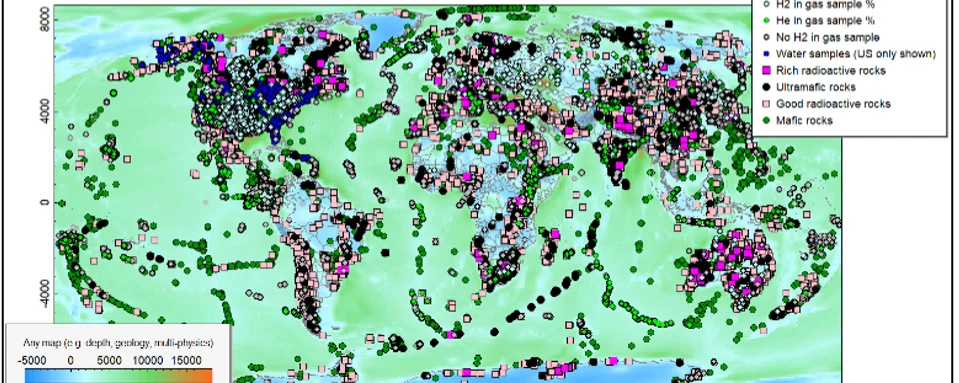

The value of an integrated and multi-disciplinary approach to natural hydrogen exploration

Natural hydrogen is increasingly considered to be a viable future resource to support the energy transition. Viridien, an advanced technology, digital and Earth data company, is providing support to decision-makers in the emerging natural hydrogen industry. With over 90 years of experience in natural resource exploration, its natural hydrogen team are developing new and innovative solutions, supported by its powerful HPC capabilities, to provide integrated, multi-disciplinary approaches to de-risk natural hydrogen exploration.
Viridien has worked on natural hydrogen exploration since 2020. What started as an internal research and development program has developed into a dedicated, multi-disciplinary team as part of its Geoscience New Ventures group, providing technical expertise, solutions and services to the natural hydrogen industry. It has gained a deep understanding of the natural hydrogen system and adapted existing and proven oil and gas workflows to the new industry as well as developing new ones. The focus of its work is how to identify accumulations of natural hydrogen that are targetable and testable on commercial scales.
Viridien has developed a four-step program, covering various scales, from global to local, to support clients at different stages of the exploration cycle.
It has created a global integrated database (Figure 1) that includes hydrogen and associated gases, information on abundances and isotopes, rock data covering ultramafic and mafic rocks, including elemental analysis, and, finally, an extensive amount of water chemistry.
Leveraging its satellite mapping, machine learning and multi-physics expertise, it has developed a range of solutions. This includes the detection and categorization of hydrogen surface seeps (‘fairy circles’) using machine learning and providing a geological interpretation to link surface features with a working hydrogen system at depth. Its multi-physics experts have also explored how 3D models of the crust, integrated with resistivity and magnetic data, can help to improve understanding of hydrogen source systems and fluids at depth.
Using oil and gas industry standard play-based exploration approaches, Viridien has developed hydrogen play concepts and screening workflows to high-grade areas for hydrogen potential quickly and efficiently on global to local scales. The team have also conducted in-depth studies on source system characterization and have extensive knowledge of how crustal structure can impact migration of hydrogen and of the importance of the role of water in hydrogen generation (Figure 2) (Olivares et al., 2024).
Viridien, recognized for its high-end seismic imaging and reservoir characterization capabilities, is currently investigating the role seismic can play in hydrogen exploration.
Initial research is focused on understanding how the presence of hydrogen can impact the properties of gas-bearing intervals. The ultra-low density of hydrogen, coupled with the fact that it is often co-associated with other gases, presents detection challenges that need to be analysed to determine how seismic data can be used efficiently for hydrogen play assessment.
Viridien, through its Sensing & Monitoring business line, marketed under the Sercel brand, has been developing advanced, cost-efficient seismic technologies for the characterization and monitoring of natural hydrogen.
Energy transition applications (geothermal, CCS, onshore & offshore wind, mining, natural hydrogen and helium) have posed challenges for seismic acquisition related to the accuracy of subsurface characterization and monitoring, operational efficiency and cost constraints. These challenges have required the introduction of additional features and performance enhancements, including much more cost-efficient seismic surveys for natural hydrogen exploration.
Key questions posed by asset owners and operators in energy transition sectors include: Can we trust the data? Where does the variability in the data come from? How can we reconcile upfront cost and OPEX over a long period of time? and how can we ensure non-intrusive, and maintenance-free monitoring installations over a very long period of time?
The industry is working hard to answer these questions. Some are already being addressed by using more efficient active seismic (using seismic sources) and now recently – passive seismic. Passive seismic exploration allows for seismic imaging of larger areas and depths down to 1000 m without a seismic source, thus significantly reducing the many cost parameters related to the use of a source. However, this technology, also known as ambient noise tomography (ANT), is still not always well understood and can have inferior results compared to a conventional survey and customer expectations. To be efficient, ANT requires a good understanding of the appropriate acquisition design, the appropriate sensor, advanced processing and geological interpretation. Viridien has this specific know-how and can offer a viable integrated ANT solution.
Microseismic monitoring for natural hydrogen kitchen characterization is also a relevant area of interest. Due to the depth of the kitchen and low magnitude of the microseismic events, efficient recording of these signals is very challenging and requires excellent sensor performance. Based on this, the use of specialized MEMs technology, which can resolve these challenges, brings significant benefits to both the active and passive (for microseismic) acquisition of data to support natural hydrogen exploration (Figure 3).
References
Olivares, C., Findlay, J., Kelly, R., Otto, S., Norman, M. and Cairns, M., 2024. A new exploration tool in the search for native hydrogen and helium. Geological Society, London, Special Publications. https://doi.org/10.1144/sp547-2023-49
Authors
Jennifer Findlay, Céline Lacombe, Jérémie Messud, Oleg Valishin and Cyrille Genet, Viridien
Register before Sept. 30 and save 10%. Places are limited for the face-to-face component.